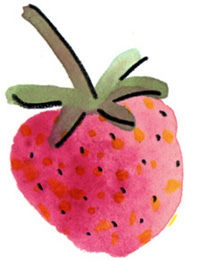Mid-to-late January in Portland is when many of the popular garden plants begin to awaken for Spring. Winter daphne buds appear and may even begin to open. The buds on the magnolias plump under the grey skies, and winter-flowering bushes like Hamamelis (witch hazel) and Edgeworthia (Chinese paper bush) begin to add new color to the garden.
Hamamelis var. Aphrodite, just beginning to unfurl its flame-colored petals
This is the beginning of our second year in this garden. After making a big push to get our front yard full and planted last spring (we felt we had something to prove after baffling our lawn-loving neighbors by ripping up the fresh sod), this year we are pivoting to focus on the back yard. Since my last post we had arborists come and clean up the mature cherry, the baby cherry, and the winter holly that thrives along the back fence. This gave us more light and a large pile of wood chips. We did the classic no-dig weed suppression method of cardboard covered with these chips in mid November, and then waited out the shortest days of late fall and early winter.
Edgeworthia chrysantha var. Akebono
Now, as the sun creeps further over the yard and lingers longer in the afternoon, we are adding to the back yard. Our goals for the back yard are native plants that provide shelter and/or food for birds. In addition, we are tucking in a few plants that provide food for us!
Asparagus
I have long dreamed of having an asparagus patch of my own, and so when the email came from Portland Nursery that asparagus is in and ready to be planted, we hopped in the car.
Handy chalkboard reference posted over the asparagus crowns at Portland Nursery
Portland Nursery asparagus pamphlet (link)
I didn’t really know what the asparagus would look like in plantable form. A bulb? A tiny green spear? I was surprised to find that it looked like a cross between a clod of dirt and one of those tentacled villain robots from The Matrix
Matrix sentinel image from kehlan on Deviantart
Following the instructions on the chalkboard, I dug three holes and planted the three crowns. (I was too lazy to dig the suggested trench). We got one of each variety from Portland Nursery. Apparently asparagi have sexes because you can get all male (better for eating, but won’t reproduce or spread), all female, or a mix.
Tag descriptions:
Sweet Purple: Male + Female, purple spears, sweet, 8-week harvest
Mary Washington: Female, high yield, 6-week harvest, uniform long thick shoots
Jersey Knight: Male, large green spears, easy care, high yield, rot and rust resistant
Each crown was $1.99.
Planted them in an L formation with the Sweet Purple at the elbow, the Mary Washington on the East leg and the Jersey Knight on the North leg. Interestingly, the all female one was smaller and daintier than the others…probably just a coincidence.
Other mid-winter plantings
We started with some good, classic Oregon plants that will be the anchors of the back yard.
Acer circinatum, vine maple. Good fall color, Oregon native, and less expensive than Japanese maple
Mahonia x media “Winter Sun” Oregon grape. We learned after the fact that despite having “Oregon” in the name, this is a relative of the native Oregon grape that’s from China. Regardless, hummingbirds love it and it looks great to boot.
Cornus sericea “Isanti” red twig dogwood.
Ribes sanguineum, flowering red currant
Yuzu! not a native, but the best citrus for our climate. Is supposed to be hardy to 0 degrees F.
And that’s where we are! Getting really excited for year two and all the fun of watching the plants from last year grow and adding new ones wherever we can find space.









